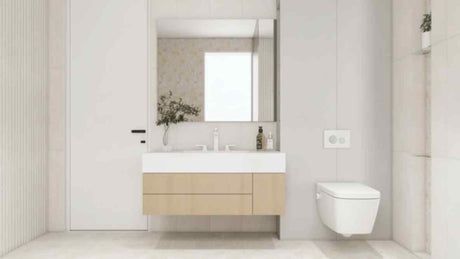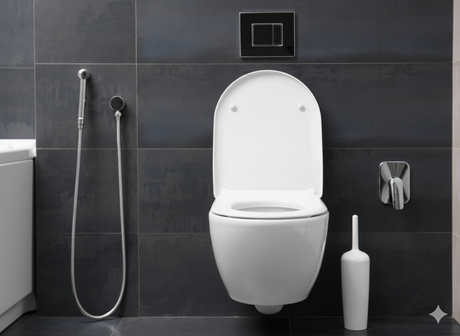Composting toilets are becoming a smart alternative for homes facing water limits, tricky plumbing, or unreliable septic systems. Instead of flushing litres of water, they rely on natural processes to turn waste into usable compost. Many people wonder, how does a composting toilet work and whether it's practical for everyday use. In this guide, we'll break down the basics, explore different methods, and share tips to keep your system running smoothly. By the end, you'll see why composting toilets are not only eco-friendly but also a reliable option for modern households.
What Is a Composting Toilet and How Does It Transform Waste?
A composting toilet is essentially a compact waste recycling system that transforms human waste on-site without using litres of water. Instead of flushing, it relies on natural biological processes to break down material, working with nature rather than against it. The answer lies in aerobic decomposition, the same process used in garden composting. Oxygen-loving bacteria convert waste into carbon dioxide, water vapour, and stable compost, while temperatures of 40–60°C help eliminate harmful pathogens and support beneficial microbes. This controlled environment ensures safe, efficient waste transformation and makes composting toilets a sustainable alternative to traditional systems.

Key Components That Make It Work
When people ask how does a composting toilet work mechanically, the answer comes down to a few essential components working together:
- Composting chamber (40–80 litres): The main space where decomposition takes place.
- 12V ventilation system: Maintains constant airflow, drawing 1–2 cubic metres of air per hour to control odours and support aerobic bacteria.
- Mixing mechanism: Can be manual or automatic, turning waste every few days to speed up decomposition.
- Liquid separation system: Uses urine diverters to prevent oversaturation and maintain the right moisture balance.
- Access doors: Allow easy addition of carbon material, like sawdust, and removal of finished compost.
- Carbon storage: Keeps sawdust or other bulking agents close at hand for ongoing use.
Together, these elements show that composting toilets are simpler than they look, yet precisely engineered for efficiency.
The 5-Step Process: How Does a Composting Toilet Work Daily
Understanding the working process helps homeowners use and maintain the system with confidence. The following five stages explain how a composting toilet works in practice:
- Step 1: Waste Separation and Collection – Modern designs separate liquids from solids at the source to avoid odour problems.
- Step 2: Aerobic Decomposition – A built-in ventilation system supplies oxygen to aerobic bacteria, preventing unpleasant smells.
- Step 3: Carbon Material Addition – Add a small amount of carbon-rich material after each use to balance nitrogen levels and support decomposition.
- Step 4: Moisture and Odour Control – Ventilation regulates humidity; extra carbon can stabilize moisture and minimize odours.
- Step 5: Compost Maturation and Harvesting – Over 6–12 months, waste transforms into stable, odourless compost. Allow at least 12 months of curing before use.
Types and Benefits of Composting Toilets for Australian Homes
Choosing the right system determines efficiency, cost, and ease of maintenance. Understanding how a composting toilet works across different models helps you select the best option.
Self-Contained Units – Compact and Practical
These combine the toilet and composting chamber in a single unit, ideal for granny flats, cabins, and tiny homes. Prices: $1,500–$3,000. Require monthly emptying but straightforward to install.
Central or Remote Systems – Best for Families
Toilet connected to a large composting chamber beneath the floor or in a separate space. Suitable for 4+ people, cost $8,000–$15,000 installed, emptied once or twice per year.
Portable Toilets – Off-Grid but Limited
Often marketed as composting toilets, but many are dry/chemical toilets. Cost $800–$1,500, suitable for caravans or occasional use, but lack full composting function.
Proven Benefits That Make the Investment Worthwhile
- Water Savings: Save up to 8,000 litres annually, cutting household bills by $300–$500.
- Environmental Impact: Prevent ~2 tonnes of CO₂ per year while producing safe compost.
- Cost Efficiency: Systems pay for themselves in 3–5 years and reduce septic pump-outs ($200–$400/year).

Installation, Maintenance and Troubleshooting Guide
Professional vs DIY Installation
Self-contained units can be installed DIY; central/remote systems require professional installation ($1,500–$3,000). Ensure level floor, vent pipe routing, access to power, and room for maintenance.
Essential Maintenance and Troubleshooting
- Daily: Add carbon material after each use.
- Weekly: Check 12V fan is running.
- Monthly: Inspect chamber and moisture levels (40–60%).
- Quarterly: Check vent pipe for blockages.
- Yearly: Replace air filters to maintain airflow and odour control.
Common Issues: Odour usually indicates insufficient carbon, poor ventilation, or excess moisture. Correct by proper venting, adding carbon, and balancing moisture.

Australian Regulations and Getting Started
Understanding regulations ensures compliance and safe installation.
State-by-State Requirements
- NSW: Must be installed by certified professionals, approvals by local councils.
- Victoria: DIY possible with appropriate permits (EPA Victoria Guidelines).
- Queensland: Approvals managed by local councils under Plumbing and Drainage Act.
- WA & SA: Department of Health approval; only accredited models allowed.
- Tasmania & NT: Case-by-case approvals with groundwater protection.
Health Department Standards
Systems must include proper ventilation, sizing for user numbers, 12-month minimum compost curing, and maintain records. Units cannot risk contaminating watercourses or food gardens. Must meet AS/NZS 1546.2 standards.
Conclusion
Starting with a smaller unit or visiting a demonstration site helps understand how a composting toilet works. They offer long-term cost savings and environmental benefits. Modern composting toilets meet health and safety standards and are a reliable alternative to flush toilets.
FAQs
Do Composting Toilets Smell Bad?
Properly maintained composting toilets do not smell. Odour usually indicates insufficient carbon or poor ventilation.
How Often Do You Empty a Composting Toilet?
Self-contained units: empty about once a month. Central/remote systems: once or twice per year.
Can Composting Toilets Freeze in Winter?
Most models handle mild frost; insulation or heating may be needed in very cold climates. Proper installation reduces winter issues.
Are Composting Toilets Legal in Australia?
Yes, when installed according to regulations. Approval processes vary by state. Accredited models ensure compliance.








